Loctite is not the end of the world, it just depends on what type they've used.
Loctite is actually a trade name and they have hundreds of different adhesives, it's a bit like calling all vacuum cleaners 'hoovers', they're not.
I use two types of Loctite, both industrial from my previous employment. 603 which will hold crane wheels to shafts, serious heavy tonnage adhesive, it'll hold crank axles just fine. The other is 2400 which is more gentle and is technically called a thread lock adhesive, it's great for top hat bearings and axle screws, it'll hold them in place but easily loosened with the correct tools.
Brian, regarding the Hall, stop faffing around

, turn it on it's side, support the underside with cloth to prevent damage and drill out the countersunk head with a 3.5/4 mm drill, you'll get so far and the head will just spin off, flip the model over and do the same the other side, if you can get the coupling rods off (do this after the drilling as you can grip another wheel and the rods will stop the one your drilling spin around when the drill breaks through) then both wheels will come off the axle just fine. Replace the axle and new screws and off you go. The frames won't get in the way at all as you're working outside of them.
You may actually find that the local heat from the drilling and vibration is enough to loosen the screw and it'll start to unwind, I've had that a few times.
Your screws may not have been fixed in place, it's not uncommon for the screw to rust in the axle, I've had a few of those, given this is a garden railway it may just have rusted solid, you could try a squirt of WD40 and leave it for a few hours and then try to get the screw out. Personally I'd not waste the time, drill it out, fit new axle, go down the pub.
All the other ideas are lovely but sometimes you just have to keep it simple and agricultural.
Here's one I made earlier.
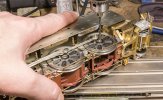
Your loose wheels will probably be due to one of two primary causes, the first (least likely) is burs on the square end of the shaft when assembled, they've now rubbed off over time and the wheel has settled onto the shoulder and is sloppy.
Second and more likely, the countersink in the axle end is not deep enough and when the screw is tightened up it does not grip or hold the wheel in place. To resolve that you'll need to deepen the countersink....best done in a lathe with the correct countersink bit to match the Slaters screw head.
There is a possible third option, swarf or debris in the bottom of the screw thread which is stopping the screw from fully tightening.

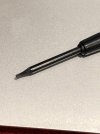
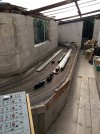
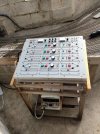
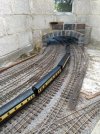
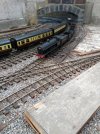
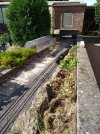
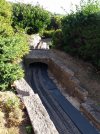

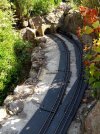
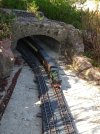
 , turn it on it's side, support the underside with cloth to prevent damage and drill out the countersunk head with a 3.5/4 mm drill, you'll get so far and the head will just spin off, flip the model over and do the same the other side, if you can get the coupling rods off (do this after the drilling as you can grip another wheel and the rods will stop the one your drilling spin around when the drill breaks through) then both wheels will come off the axle just fine. Replace the axle and new screws and off you go. The frames won't get in the way at all as you're working outside of them.
, turn it on it's side, support the underside with cloth to prevent damage and drill out the countersunk head with a 3.5/4 mm drill, you'll get so far and the head will just spin off, flip the model over and do the same the other side, if you can get the coupling rods off (do this after the drilling as you can grip another wheel and the rods will stop the one your drilling spin around when the drill breaks through) then both wheels will come off the axle just fine. Replace the axle and new screws and off you go. The frames won't get in the way at all as you're working outside of them.